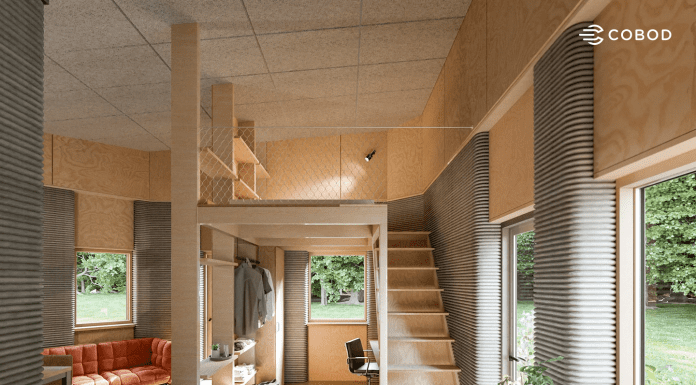
Europe’s largest 3D printed housing project has reached a key milestone with the completion of the onsite printing phase
3DCP Group has produced 36 student apartments in Holstebro, Denmark, using COBOD’s BOD3 construction printer for NordVestBO, an affordable housing organisation.
Located near VIA University College’s Holstebro campus, the development features six buildings, each containing six student apartments that together form a connected 3D printed student house community.
The total printed area is 1,654 sq m across six buildings. Each building contains six apartments ranging from 40 sq m to 50 sq m.
The project, named Skovsporet or “the Forest Trail”, aims to demonstrate the potential for 3D printing to build faster, more efficiently and at scale.
Printing time was reduced from several weeks on the first building of six apartments to just five days on the last, equal to more than one apartment per day.
3DCP Group used the COBOD BOD3 printer to achieve millimetre accuracy across all printed walls, operated by a three-person team.
The BOD3’s ground-based track system, specifically designed for residential construction, allowed the printer to extend easily along the Y-axis, enabling uninterrupted printing of long wall sections.
Supporting sustainability
Beyond productivity, the project also demonstrates how 3D printing supports sustainability both in material use and environmental integration.
The 3D printed walls were made using D.fab concrete with FUTURECEM, a low-carbon cement developed by Aalborg Portland.
Because the printing process deposits material only where it is structurally required, waste generation is significantly lower than in conventional construction.
The project was also designed to respect its natural surroundings, with print beds carefully positioned between existing trees to preserve 95% of the site’s trees, a clear demonstration that advanced construction methods and sustainable design can coexist.
Designed by SAGA Architects, the project shows how 3D printing can be combined with traditional materials to create modern, practical spaces. The 3D printed walls form the foundation of the student apartments, each including a kitchen, study area, lounge, bathroom and double bed.
Large roof windows and slanted ceilings fill the units with natural light, creating open, inviting spaces.
The six buildings are arranged around shared courtyards to encourage community living, while the use of coated plywood and glass complements the printed concrete to give each apartment a warm and distinct character. Beyond the homes, landscaped gardens, walking paths and bicycle parking enhance the sense of community
With printing now complete, work will begin on interior construction.
3D printing ‘ready for large-scale projects’
“The results at Skovsporet show how 3D construction printing can deliver large-scale projects faster and more efficiently than ever before,” said Henrik Lund-Nielsen, founder and general manager of COBOD International.
“With the BOD3 printer, we achieved continuous improvements in productivity from one building to the next, confirming that the technology is ready for multi-unit residential developments. This project is a strong example of how automation impacts the speed of construction.”
Mikkel Brich, co-founder of 3DCP Group, added: “Skovsporet proved that 3D construction printing can meet the strict requirements of subsidised housing while delivering high precision and productivity.
“As we deepened our understanding of the technology, we increased productivity from one building to the next, and are confident we can build even faster in future projects.”
The post Europe’s largest 3D printed housing project reaches key milestone appeared first on Planning, Building & Construction Today.

